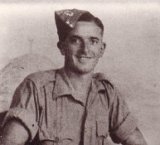The ancient Parish of Carew lies in a picturesque location about five miles from Pembroke, on the road to Narberth. The Parish lies on the River Cleddau, just on its tidal extremities, near to which is sited the mediaeval Carew Castle. The War Memorial takes the form of a marble obelisk, upon which are engraved the names of the fallen of the parish from both world wars, which was unveiled on 1 September 1929. The photographs of the memorial are courtesy of Les Nixon while the photographs of most of the men are courtesy of Deric Brock.
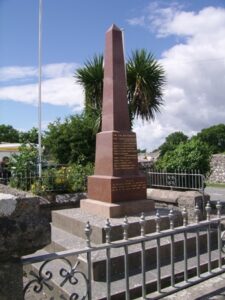
The Great War, 1914-1918
William Thomas Arthur, Private, 54130, Welsh Regiment. William was born in 1896, the son of George and Martha Arthur, of White Hill, Carew. He enlisted at Carmarthen into the 15th Battalion of the Welsh Regiment, which was the Carmarthenshire Battalion. In 1915 the Battalion became part of the 114th Brigade, 38th (Welsh) Division, and moved to the Western Front in December 1915, taking up positions near Fleurbaix. They fought with distinction at Mametz Wood the following year, and in 1917 played a major part in the capture of the Pilckem Ridge during Third Ypres. They were rushed to the Somme in spring 1918 to help stem the German push towards Amiens, and then took part in the great offensive of August 1918, where they forded the flooded River Ancre on the night of 22 August 1918 which began the great drive to victory. The Division pushed steadily through Pozieres and Longueval, capturing the village of Morval, which is where William was killed on 1 September 1918. He was 22 years old, and is buried at Morval British Cemetery, France.
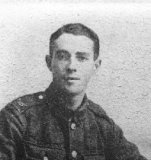
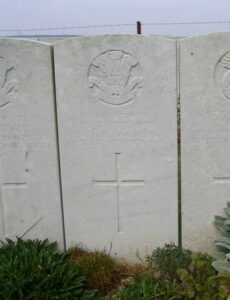
Sir Thomas Carew Trollope (Baron Kesteven), Captain, Lincolnshire Imperial Yeomanry. Thomas was born in May, 1891, the only son of Honorable Robert Cranmer Trollope and Mrs. Trollope, of Crowcombe Court, Taunton. He was educated at Eton, and succeeded to the Baroncy after the death of his Uncle in July 1915. Thomas joined the Lincolnshire Yeomanry in 1908, when his Uncle was Lieutenant-Colonel of the Battalion, and at the outbreak of war was Gazetted Captain, moving to France attached to the Jacob’s Horse, Indian Cavalry. He returned to Britain after receiving the Baroncy, and was posted to the Balkans. Thomas was wounded aboard the S.S. Mercian, when she was shelled on 3 November, and sadly died as a result in Hospital, at Oran, Algiers on 5 November 1915. His body was brought home for burial at the Trollope family’s ancestral vault at Crowcombe (Holy Ghost) Church in Somerset. He was just 24 years old, and being unmarried, the title of Lord Kesteven died with him.
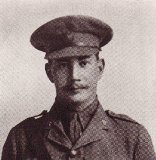
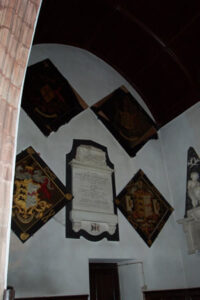
Charles Llewellyn Cole, Private, 19664, York and Lancaster Regiment. Charles was the son of Benjamin and Louisa Cole, of Carew Mountain, Cresselly. He enlisted at Neath into the Army. He joined the 10th Battalion, York and Lancaster Regiment, which was attached to 63 Brigade, 21st Division. The Division crossed to France between 2 and 13 September 1915, and its first experience of battle was truly appalling. Having been in France for only a few days, lengthy forced marches brought it into the reserve for the British assault at Loos. GHQ planning left it too far behind to be a useful reinforcement on the first day, but it was sent into action on 26 September, whereupon it suffered over 3,800 casualties for very little gain. They moved to the Somme in 1916, and fought at the Battle of Albert, going over the top on the opening day of the battle, on 1 July 1916. Charles was one of almost 20,000 men who died on that first day of the fighting; the worst disaster in the history of the British Army. He was 22 years old, and like so many others who died in that terrible battle, he has no known grave, and is commemorated on the Thiepval Memorial, France.
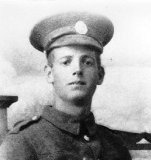
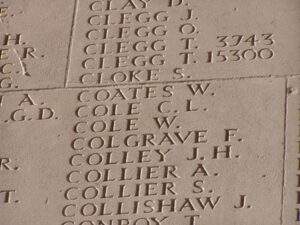
Herbert Thomas Davies, J/28606, Ordinary Seaman, Royal Navy. ‘Tom’ was born at Carew in 1897, the son of Mr. and Mrs. Benjamin Davies. The family later moved to Glanteifon Cottage, St. Dogmaels. Herbert served aboard the mighty Battleship, HMS Queen Mary which was launched in 1912, joining the 1st Battlecruiser Squadron of the Grand Fleet. At the outbreak of the Great War, the Queen Mary was in the North Sea, and took part in the successful Battle of Heligoland Bight on 28 August 1914. During the first two months of 1915 the Queen Mary undertook a refit at Portsmouth, before again rejoining the Grand Fleet. During May, 1916 the Grand Fleet faced what was to become their sternest test of the war. Information had been received that the mighty German High Seas Fleet were assembling, and on 30 May the Grand Fleet put to sea. During the following afternoon of 31 May 1916, the great fleets sighted each other, and began what was to be the greatest Naval Battle in History, with the Queen Mary in the thick of the action. After exchanging heavy salvoes with their German opponents, the Queen Mary suffered direct hits from the Seydlitz and Derfflinger, and blew up with the loss of 1,266 crew. Herbert was one of these poor souls to lose his life in the tumultuous explosion caused by the direct hits, and so he is remembered on the Plymouth Naval Memorial in Devon. He was just 18 years old. Tom is not commemorated on the St. Carew Memorial.
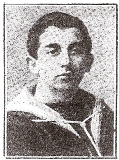
Osborne William Griffiths, Private, 13425, Coldstream Guards. Osborne was born in 1881, the son of George Llewhellin Griffiths and Edith A. Griffiths of Pembroke. He resided at Carew prior to the war, and enlisted at Hayward’s Heath into the Coldstream Guards. Osborne was posted to the 3rd Battalion, Coldstream Guards, which was attached to 4th (Guards) Brigade, 2nd Division. The Division moved to France at the outbreak of war, and fought from the opening Battle of Mons, through the retreat south to the Aisne. The Guards were at the forefront of the fighting in France. On 20 August 1915 the 3rd Battalion transferred to 1st (Guards) Brigade, Guards Division, and took part in the Battle of Loos, which was launched on 25 September 1915. It was at Loos that Osborne was wounded on 30 September 1915, and returned home for treatment. Sadly he died of his wounds on 16 November 1915 aged 34, and is buried at Carew (St. Mary) Churchyard.
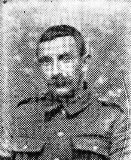
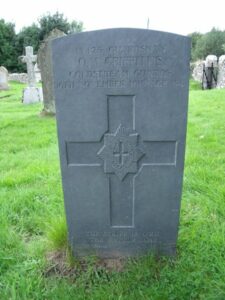
Arthur Lloyd Grote, Captain, Royal Engineers. Arthur was the son of George Whitcombe Grote, M.D. and his wife Mary. He was the husband of Nina Patricia Grote, and the father of Shelagh, of 12, Evelyn Court, Cheltenham. At the outbreak of war, Arthur was serving as a Lieutenant with the 1st Volunteer Battalion, Welsh Regiment. He was commissioned into the Royal Engineers, was made Temporary Captain in January, 1915, serving as a Brigade Musketry Instructor. He was promoted to full Captain on 7 March 1917, and attended the Inland Water Transport branch of the Royal Engineers. Arthur died on 9 July 1918 in Basra, aged 45, and is buried at Basra War Cemetery, Iraq.
Thomas Harries, Private, 36255, Loyal North Lancashire Regiment. Thomas was the son of John and Sarah Harries, of Little Freestone, Cresselly. He enlisted at Cardiff into the Army, and joined the 2nd Battalion, Loyal North Lancashire Regiment, which was part of 232 Brigade, 75th Division. The Division served in Egypt and Palestine, taking part in the Third Battle of Gaza (in which the Division played a part in the Capture of Gaza). They then fought at the Capture of Junction Station, the Battle of Nabi Samweil, the Battle of Tell’Asur, the Battle of Berukin, and the Battles of Megiddo (in which the Division took part in the Capture of Sharon). They remained in Palestine for the duration of the war. Thomas was one of a batch of reinforcements for the Division, and had sailed on board the Transport Ship Transylvania, bound for the Middle East. On 4 May 1917 the Transylvania was torpedoed and sank with the loss of more than 400 lives, one of whom was the 36 year old Thomas. He is commemorated on the Savona Memorial, Italy.
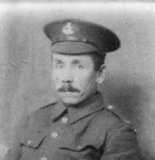

Jesse Harvey, Private, 79767, Canadian Infantry. Jesse was born in Carew on 13 April 1885, the son of Jesse and Sarah Stone Harvey. The family had moved to Bishop Stoke, Hampshire when Jesse was young, and he emigrated from there to Canada prior to the war. He enlisted at Calgary on 24 November 1914 into the 31st (Alberta) Battalion, Canadian Infantry. The battalion sailed from Canada on 17 May 1915 and after training at Salisbury Plain sailed for France on 18 September 1915, as part of the 6th Infantry Brigade, 2nd Canadian Division. The division saw its first action at the St. Eloi craters, near Ypres, and then during June saw heavy fighting around Mount Sorrel. At the beginning of September 1916 it began moving south towards the Somme sector and by 8 September had reached Albert. The 31st Battalion began moving towards the front line near Pozieres the following night, taking over the ground in front of Mouquet Farm, which had been gained at great cost by the Australians. After four days of heavy fighting the battalion moved back to billets in Warloy, and by 25 September was again marching back into the front, which had moved forwards to Courcelette. On the morning of 26 September the battalion launched an attack against the Germans at Courcelette, and suffered heavy casualties in doing so. Jesse, who by then was 37 years old, was posted as missing, presumed killed in action on 27 September 1916. His body was later found, and he is buried in Courcelette British Cemetery, France. Jesse does not appear to be commemorated locally.
Thomas Lewis, Private, 7158, Welsh Regiment. Thomas was born at Carew, the son of James and Sophia Lewis. His parents later resided at 13, North Brewery Street, Pembroke Dock. He was a regular soldier, after having enlisted into the Welsh Regiment at Cardiff several years prior to the war, and was posted to the 3rd (Reserve) Battalion, which was at the time based at Maindy Barracks, Cardiff. Thomas must have then been attached to the 2nd Welsh in France, before being wounded and returning home for treatment. He was then based back at Cardiff Barracks while convalescing, but was found dead in the Glamorgan Canal on 7 September 1915 aged 39. Thomas was buried at Cardiff (Cathays) Cemetery.
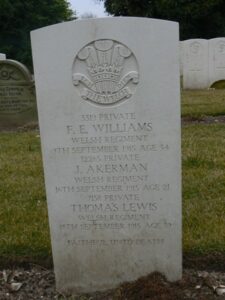
John Austin Llewhellin, Private, 320266, Welsh Regiment. John was the only son of George and Mary Llewhellin, of Stephens Green, Milton, Pembroke. He had originally served with the Pembroke Yeomanry, but in early 1917 the Regiment was merged with the Glamorgan Yeomanry in Egypt to form the 24th Battalion of the Welsh Regiment. The Battalion was attached to 231 Brigade, 74th (Yeomanry) Division, and saw its first action during the march into Palestine in 1917, fighting in the Battle of Gaza. It was later in the year, during the Third Battle of Gaza, that John was wounded, and as a result died on 2 November 1917. He was just 22 years old, and is buried at Beersheba War Cemetery, Israel.
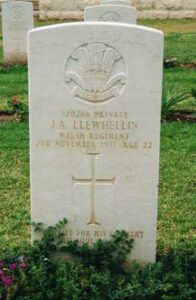
George Edward Pask, Shoeing Smith, 696146, Royal Field Artillery. George was born at Devonport on 16 July 1894, the son of George and Mary Pask. His mother Mary (nee Webb) was from Carew, and George was a regular visitor there, settling at Milton. He enlisted at Cardiff into the 3rd Welsh in May 1915, but was discharged as medically unfit three months later. He then re-enlisted at Weeton Camp, Yorkshire into the Royal Field Artillery, and was attached to the 57th Division Ammunition Column, which was a Territorial Division, raised in Lancashire in 1915. The Division moved to France during 22 February 1917, and moved to positions near Ypres, where they took part in the Second Battle of Passchendaele. This is where George was wounded. He died as a result on 20 October 1917 and is buried at Cement House Cemetery, Belgium.
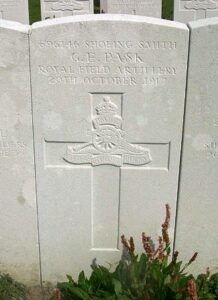
Alfred Perkins, Private, 19894, Royal Welsh Fusiliers. Alfred was the son of Mr. and Mrs. Evan Perkins, of Freestone Cross, Cresselly. He enlisted at Maesteg into the 1st Battalion, Royal Welsh Fusiliers, which was a Regular Army Battalion that had been in France since the outbreak of war. In 1916 the Battalion was attached to 22 Brigade, 7th Division, and had been moved to the Somme after taking part in the Battle of Loos. It was just two months into the Somme offensive that Alfred was killed at Delville Wood on 3 September 1916. He is buried nearby, at Delville Wood Cemetery, Longueval, France.
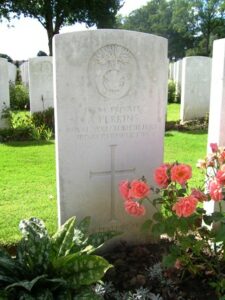
William Scourfield, Private, 29530, South Wales Borderers. William was the son of John and Catherine Scourfield, of Cresswell Quay, Cresselly, and had served with the 3rd Battalion, South Wales Borderers on Home Service, guarding the dockyards at Liverpool. He became ill and died of sickness at Liverpool Military Hospital on 26 February, 1917 aged just 18. His remains were brought home for burial in Pisgah Baptist Chapelyard.
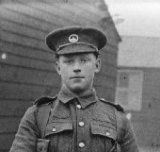
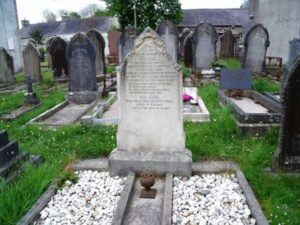
World War Two, 1939-1945
Anthony Froude Trollope-Bellew, Lieutenant, 222332, Rifle Brigade. Anthony was the nephew of Lord Kesneven, and the son of Colonel Froude D. Trollope-Bellew, DSO, MC, and the Hon. Mrs. Nesta Trollope-Bellew, of Crowcombe, Somerset. Anthony served as a Lieutenant in the 2nd Battalion, Rifle Brigade, which moved to North Africa as part of the British 7th Motor Brigade. The Battalion fought with great distinction during the Second Battle of El Alamein at the end of 1942, which is where Anthony was killed on 2 November 1942. He was just 20 years old, and is buried at El Alamein War Cemetery, Tunisia.
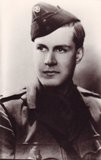
Stanley George Boswell, Corporal, 3957794, Royal Hampshire Regiment. Little is known of Stanley, but he served with the 7th Battalion, Royal Hampshire Regiment. The Battalion was a Territorial unit, and was sent to Normandy as a reinforcing unit after D-Day, landing on 22 June 1944 at Le Hamel attached to 130 Brigade. On 10 July 1944 the 7th Battalion attacked Maltot, supported by tanks of 44th RTR. The village was defended by Waffen SS troops supported by Tiger tanks, and the Battalion suffered severe casualties, but was back in the line two days later. On 30 July 1944 the 7th Battalion attacked the village of Cahagnes, fighting in typical ‘bocage’ countryside, but after the initial attack by the brigade ran into difficulties, 7th Battalion deployed from reserves and captured Cahagnes, beating off several German counter-attacks. On 2 August the 7th Battalion moved up to Jurques, and after a short stiff fight advanced to “Point 132”, close to Mount Pincon. On 6 August the 7th Battalion put in a deceptive attack on Mount Pincon, making a diversion whilst 129th Brigade made a flank attack. During heavy fighting, “C” company lost many casualties, including all the officers. Following the successful flank attack by 129th Brigade, the 7th Battalion mopped up and concentrated near Mauny by 10 August. Stanley was killed in action on 9 August 1944, aged 30. He is buried at Bayeux War Cemetery, France.
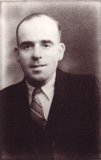
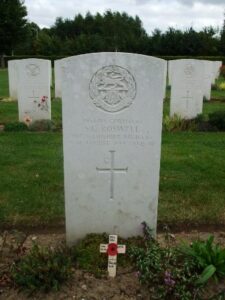
Eric Brock, Lance Corporal, 2008307, Royal Engineers. Eric was the son of William and Elizabeth Ann Brock, and the husband of Lucy May Brock, of Pembroke. He served with 284 Assault Squadron, Royal Engineers, which was an armoured assault unit. Eric landed on the Normandy Beaches in June 1944, and took part in the break out of Normandy, and the drive north towards Belgium. On 20 October 1944, at a farm on Isabelleweg near the town of Ijzendijke, a horrific explosion occurred, which caused the death of forty-one British and Canadian soldiers and caused injury to another fifty-one some of which would be fatal. One of the dead was Eric. He was killed on 20 October 1944, aged 25, and is buried at Adegem Canadian War Cemetery. The explosion was never fully investigated, but at the time, the men of 284 Assault Squadron were busy repairing and refuelling several tanks, and it is thought that an unstable load of nitro-glycerine had exploded, killing the men.
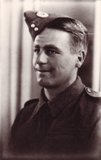
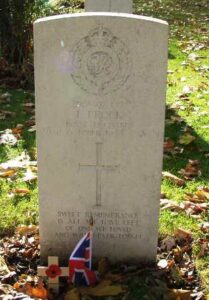
Edwin Cook, Private, 4031749, King’s Shropshire Light Infantry. Edwin was born in Carew, the son of George Thomas Cook, and Mary Ann Cook. He was the husband of Ada Cook, of Altrincham, Cheshire, and served in the 1st Battalion, King’s Shropshire Light Infantry. The Battalion was based on the Maginot Line at the outbreak of World War Two, and it was here that Edwin was killed, on 21 May 1940. He was 26 years old, and is buried at Froyennes Communal Cemetery, Belgium.
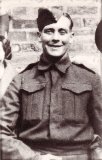
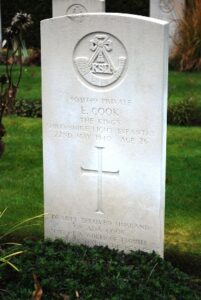
Corlis St. Leger Hawkes, Pilot Officer, 128712, Royal Air Force Volunteer Reserve. Corlis was the son of Lieutenant Colonel Corliss St. Leger Gillman Hawkes and Eleanor Muriel Hawkes, of Milton. He was a Pilot with 267 Squadron, Royal Air Force, which had reformed in August 1940 from the Communications Unit, Heliopolis, for local transport duties in Egypt. It used a variety of types for transporting passengers, mail and freight between Egypt and outlying bases. Larger aircraft were acquired by the end of 1941 and by August 1942, operations extended throughout the Mediterranean area and its role included the movement of personnel and equipment, casualty evacuation and occasional supply-dropping missions to guerrilla bands in Italy and the Balkans. Corlis was killed in Greece on 22 October 1942, aged only 21, and is buried at Heliopolis War Cemetery, Greece.
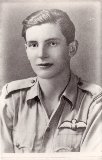
Ronald George Hay, Petty Officer Stoker, D/KX 83607, Royal Navy. Ronald was born on 1 August 1912, the son of James Hay and Inez Hay (nee Allenby). He married Gwendoline Avesnes Scourfield, of Milton, in 1938. Ronald served in the Royal Navy aboard H.M.S. Jackal. Jackal (F22) was a J-class destroyer of the Royal Navy laid down by John Brown and Company, Limited, at Clydebank in Scotland on 24 September 1937, launched on 25 October 1938 and commissioned on 31 March 1939. She was attacked by enemy German Ju-88 bombers of Lehrgeschwader 1 north-west of Mersa Matruh in Egypt on 12 May 1942 and severely damaged, and scuttled by HMS Jervis. Ronald was killed by the bombing on 12 May 1942, aged 29. He has no known grave, and is commemorated on the Plymouth Naval Memorial, Devon. His uncle Percy Hay had been killed in WW1.
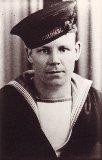
Howard Stanley John, Able Seaman, D/SSX 28198, Royal Navy. Howard was born on 12 August 1921, the son of William Alfred John and Mary Jane John (nee Roch), of Cresswell House, Cresswell Quay. He enlisted into the Royal Navy and was posted aboard the battlecruiser, HMS Repulse. She had been built in World War One, but was refitted and modernised in 1938, and operated with the Home Fleet in the North Sea and Atlantic during the first two years of the Second World War, taking part in the pursuit of the German battleship Bismarck in May 1941. Later in the year she was sent to the Far East, accompanying the new battleship Prince of Wales. The two ships arrived at Singapore just before Japan began the Pacific War. As soon as hostilities commenced, both steamed northwards to intercept a reported invasion force. While returning to Singapore on 10 December 1941, Repulse and Prince of Wales were attacked by Japanese high-level bombers and torpedo planes. Repulse was moderately damaged by bombs early in the action and was later hit by several torpedoes. After receiving this heavy underwater damage, she sank rapidly, followed less than an hour later by the Prince of Wales. Howard went down with the ship that day. He was only 20 years old, and is commemorated on the Plymouth Naval Memorial, Devon.
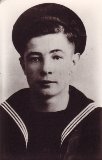
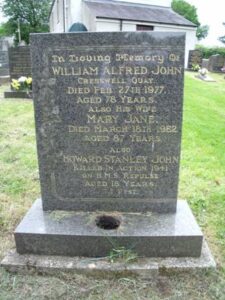
Mervyn Henry John, Guardsman, 2741236, Welsh Guards. Mervyn was born on 11 July 1927, the son of George William John and Mary Eliza John (nee Roach), of White Hill, Cresselly. Upon leaving school, he enlisted into the Welsh Guards and was posted to Aldershot for training. Mervyn died at Aldershot Military Hospital on 1 April 1947, aged just 19. His remains were conveyed home and he was buried in Pisgah Baptist Chapelyard, Carew. Mervyn’s name has recently been added onto the Carew War Memorial.
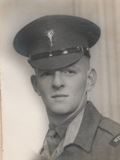
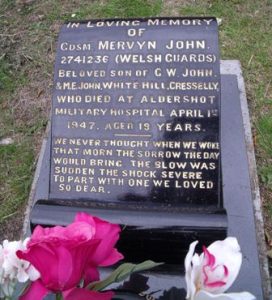
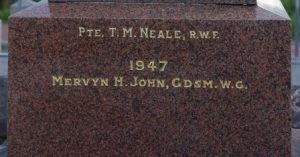
Thomas Melgwyn Neale, Fusilier, 4208890, Royal Welch Fusiliers. Thomas was the son of Edwin Neale and Mary Neale (nee Rees), of Church Farm, Redberth. He married Annie Mary Elizabeth Mason in 1941. Thomas had enlisted into the army soon after the outbreak of war and served with the 6th Battalion, Royal Welch Fusiliers, which was part of the 53rd (Welsh) Division. The Division spent most of the war on home defence in Northern Ireland and England before landing in Normandy at the end of June 1944. The division then took part in the heavy fighting to break-out of the Normandy beach-head over the coming weeks. Thomas was killed during an assault on Évrecy on 17 July 1944. The 24-year-old has no known grave, and is commemorated on the Bayeux Memorial, France. His widow, Annie, also lost her brother, James Edgar John Mason, during the war.
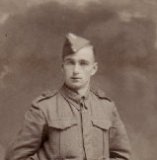
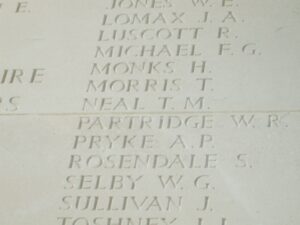
George Richard Phelps, Flight Lieutenant (Pilot), 150236, Royal Air Force Volunteer Reserve. George was the son of Joseph George and Phebe Jane Phelps, of Pembroke. He served with the Royal Air Force Volunteer Reserve, in 166 Squadron, which was a heavy bomber Squadron, flying Lancaster bombers after 1943. On the morning of 1 March 1945, George was flying Lancaster Mk 1, Serial ME447, as part of a large formation of 478 aircraft which had been despatched to bomb Mannheim. George was killed when his Lancaster was shot down in the vicinity of Umgebung that morning. He was just 22 years old, and is buried at Durnbach War Cemetery, Germany.
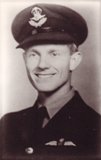
Colwyn John Scourfield, Trooper, 7933318, Royal Armoured Corps. Colwyn was born on 5 May 1916, the son of Thomas Scourfield and Elizabeth Scourfield (nee Edwards), of Ashleigh House, Sageston. He worked as a lorry driver and mechanic prior to the war. Colwyn enlisted into the army and was posted to the 50th Royal Tank Regiment of the Royal Armoured Corps. They saw action in the Western Desert and North Africa, including El Alamein, Mareth and Sfax, and then Sicily, and Italy, which is where Colwyn was killed on 19 July 1943. He was 27 years old, and is commemorated on the Cassino Memorial, Italy.

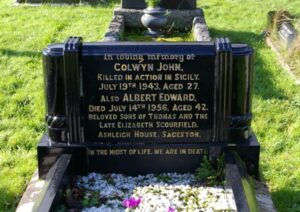
David Norman Williams, Lance Corporal, 4199432, The Royal Welch Fusiliers. David was the son of Thomas and Mary Ann Williams, of Milton. He served with the 4th Battalion, Royal Welch Fusiliers, attached to the 53rd (Welsh) Division. The Division landed on Normandy at the end of June 1944 and fought throughout the campaign in Normandy, which is where David was killed on 17 July 1944. He was 27 years old, and is buried at St. Manvieu War Cemetery, Cheux, France. His brother Wilfred also fell.
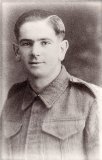
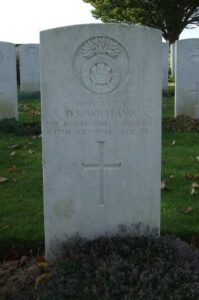
Wilfred John Williams, Driver, 219123, Royal Army Service Corps. Wilfred was the son of Thomas and Mary Ann Williams, of Milton. He served with the Royal Army Service Corps in North Africa, and was killed there on 2 July 1942, aged 32. Wilfred is buried at Tripoli War Cemetery, Libya. His brother David also fell.
